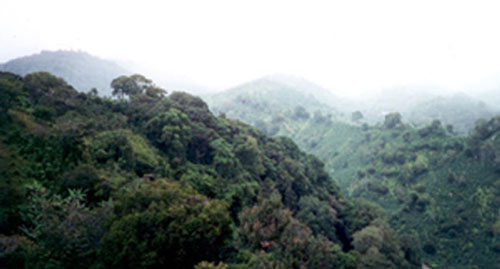Swing through the trees with monkeys. Listen to the sweet songs of birds. Find out just how long an anaconda can be. Check out the following books, DVD and specimens in the Naturalist Center, as well as other resources. Then experience what its like to walk through the different layers of a rainforest in our Rainforests of the World exhibit.
Book and Media Reviews
Newman, Arnold. Tropical Rainforest: A World Survey of Our Most Valuable and Endangered Habitat with a Blueprint for its Survival.New York: Facts on File, 1990. Naturalist Center QH541.5.R27 N49 1990
Arnold Newman is a science writer and conservationist, as well as a superb photographer. He starts this book with a lively and detailed description of the rainforest and follows this with a section looking at the inhabitants of the rainforest and how their lives are inter-related and interdependent. Newman’s main theme, however, is the human threat to the rainforests from timber extraction, slash and burn agriculture, fuel wood collection, cattle grazing, mining, and pollution. He looks at each of these in some detail and vividly creates a picture of what we lose if these activities are allowed to continue without restraint. In the final section of the book, Newman gives a ‘blueprint for survival’ with some well-argued proposals for managing the forests without further destruction through use of sustainable production techniques.
The early descriptive sections of the book are well written and packed with many gorgeous photos. The latter part of the book is much more text heavy, with some photographs and many charts and diagrams. However as Newman clearly feels passionately about the destruction of the rainforest and possible solutions to this, it remains very readable.
Read an engaging book or seen a fabulous movie about rainforests? Share the title and why you liked it with us below in our comments section.
Featured Creatures

Photo: M. Flannery
Green Anaconda Skin
Found in the Amazon basin and other parts of South America, green anacondas (Eunectes murinus) sport blotched scales that camouflage them against rainforest vegetation. These ambush predators lie in wait along the shallow waters of swamps and flooded forests for prey that includes fish, birds, reptiles . . . pretty much any animal with a backbone. Despite their formidable size and notorious onscreen reputation, these large boas only have received a few authenticated reports of eating humans. They can grow up to 9 m (29.6 ft), but the average adult length is 5 m (16.5 ft). The Naturalist Center’s snakeskin is 3.62 m (11.9 ft) and lost its green coloration during preservation.
Don’t forget to visit our live anaconda curled up in the Flooded Amazon Exhibit in the Steinhart Aquarium.

Photo: G. Sharlow

Photo: G. Sharlow
Blue Morpho
Now you see ‘em, now you don’t. At rest, the earth-toned undersides of blue morpho butterfly (Morpho species) wings make them difficult for birds and other predators to detect. Eyespots along wing edges also create the illusion that a bigger creature is staring back at them. Blue morphos’ flashier side is revealed when they take flight. The backs of their wings are a brilliant aqua blue with the wings of males being particularly iridescent. As they open and close their wings, the butterflies’ bright blue and dull-brown colors flash, creating the illusion that they are disappearing and reappearing.
Watch blue morphos and a variety of other Costa Rican butterflies flutter about the Academy Rainforest.
Want to find out more about rainforests and their inhabitants? Visit:
Amazon Interactive
http://www.eduweb.com/amazon.html
Passport to Knowledge: Live from the Rainforest
http://passporttoknowledge.com/rainforest/intro.html
PBS Journey into Amazonia
http://www.pbs.org/journeyintoamazonia/index.html
Rainforest Alliance Learning Site
http://www.rainforest-alliance.org/education.cfm?id=kidsmain


